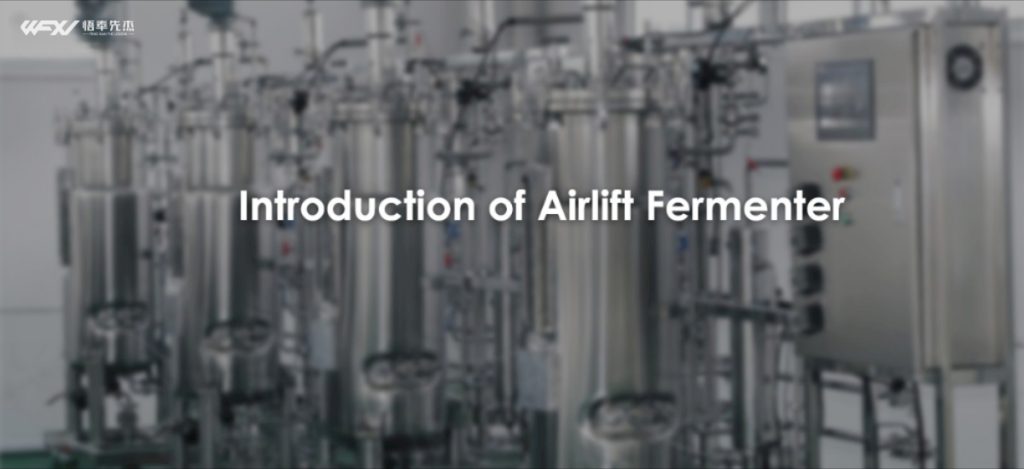
Airlift fermenters are also the most widely used biological reaction equipment. This type of reactor has the advantages of simple structure, not easy to contaminate bacteria, high efficiency of dissolved oxygen, and low energy consumption.
There are many types of air-lift fermenters, the common ones are air-lift circulation, bubbling, air jet, etc. The air-lift fermenters that have been widely used in the biological industry include air-lift inner circulation fermenters, gas-liquid double jets Airlift circulating fermenter, tower type airlift fermenter with multi-layer distribution plate. The bubbling tank is the most original aerated fermentation tank. Of course, there is no guide tube in the bubbling reactor, so the directional flow of the main body of the liquid is not controlled. Now take the airlift loop reactor as an example to illustrate its working principle.
Working principle of airlift fermenter
The airlift fermenter has no agitator in the reactor, and there is a guide tube in the center, which divides the fermented mash into the rising area (in the guide tube) and the descending area (outside the guide tube). The lower part is equipped with air nozzles, or annular air distribution pipes, and there are many nozzle holes below the air distribution pipes. Pressurized sterile air is sprayed into the fermentation broth through nozzles or nozzle holes, and the air speed injected from the air nozzle can reach 250~300 (m/s), and the sterile air is sprayed into the riser at high speed, passing through the gas-liquid mixture. The turbulent flow causes the air bubbles to be divided into small pieces, which are in close contact with the fermentation liquid in the guide tube and supply the dissolved oxygen to the fermentation liquid. Due to the reduced density of the gas-liquid mixture formed in the guide tube and the jet kinetic energy of the compressed air, the liquid in the guide tube moves upward; after reaching the upper liquid surface of the reactor, a part of the gas bubbles are broken, and the carbon dioxide is discharged to the The upper space of the reactor, and the fermentation liquid that discharges part of the gas flows from the top of the guide tube to the outside of the guide tube. The fermentation liquid outside the guide tube increases in density due to the small gas content, and the fermentation liquid drops, and enters the riser again. A circulating flow is formed to realize mixing and mass transfer of dissolved oxygen.
Features of airlift fermenters
The characteristics of the airlift loop reactor have been briefly mentioned above. Since there is no agitator in the airlift loop reactor and there is a directional circulating flow, it has many advantages, which will be described in detail below.
(1) Uniform distribution of reaction solution: Uniform mixing of gas-liquid-solid three-phase and good mixing and dispersion of solution components are common requirements for bioreactors, because the distribution of flow, mixing and residence time are all affected. For many aerated fermentations with intermittent or continuous feeding, the substrate and dissolved oxygen are dispersed as uniformly as possible to ensure that the concentration of the substrate everywhere in the fermenter falls within the range of 0.1% to 1%, and the dissolved oxygen is 10% to 30%. . This is beneficial for the growth and product production of aerobic biological cells. In addition, it is necessary to avoid the formation of a stable foam layer on the liquid surface of the fermenter, so as to avoid the accumulation of biological cells on it and damage or even death. There are also medium components, especially starchy granular materials that are easy to settle, and should be able to be suspended and dispersed. Airlift loop reactors can meet these requirements well.
(2) Higher dissolved oxygen rate and dissolved oxygen efficiency: The airlift reactor has a higher gas-holdup and a specific gas-liquid contact interface, so it has a high mass transfer rate and dissolved oxygen efficiency, and the volume The dissolved oxygen efficiency is usually higher than that of the mechanical stirring tank, the kLd can reach 2000h, and the dissolved oxygen power consumption is relatively low.
(3) Small shear force and little damage to biological cells: Since the airlift reactor has no mechanical stirring impeller, the shear damage to the cells can be reduced to the lowest level, which is especially suitable for the cultivation of plant cells and tissues.
4) Good heat transfer: aerobic fermentation produces a lot of fermentation heat. For example, in the vigorous period of yeast culture, the fermentation heat is as high as 3.0-4.0×105kJ/(m3.h), while the heat transfer temperature difference is only a few degrees (°C), especially in summer. If non-chilled water is used, it is only about 3-10 °C, so a large heat exchange area and heat transfer coefficient are required. Due to the high comprehensive circulation rate of the liquid in the airlift reactor, it is convenient to install a heat exchanger on the external circulation pipeline to ensure that the fermentation heat is removed to control the appropriate fermentation temperature.
(5) Simple structure, easy to manufacture: There is no mechanical stirrer in the air-lift fermentation tank, so there is no need to install a stirring system with complex structure, and the sealing is easy to ensure, so the processing and manufacturing are convenient and the equipment investment is low. At the same time, the enlarged design and manufacture of large and super large fermentation reactors have also been realized. For example, the internationally famous ICI pressure circulation fermenter has a volume of 3000m3, and another “BIOHCH” reactor has a volume of more than 3000m3. Larger reactors such as drum Bubble tower “Bayer AG” reactor volume up to 13000m3, currently used for biochemical wastewater treatment.
(6) Convenient operation and maintenance: Because the air-lift fermenter has no mechanical stirring system, the structure is relatively simple, the energy consumption is low, and the operation is convenient, especially the leakage and contamination problem that the mechanical stirring shaft seal is prone to occur is not easy to occur.